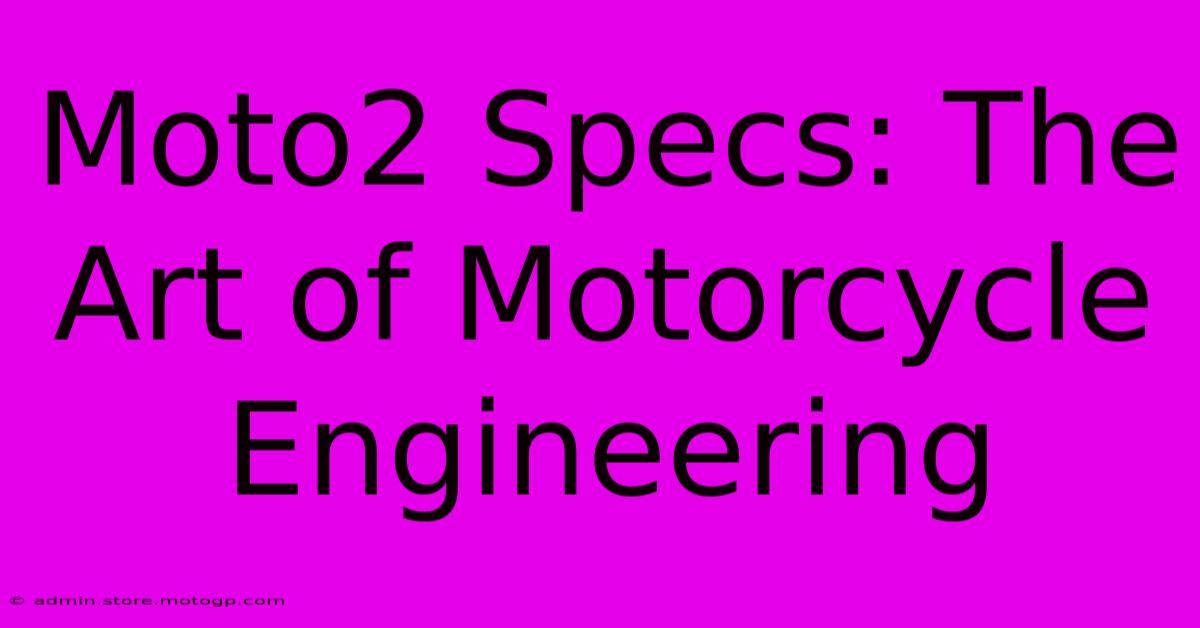Moto2 Specs: The Art Of Motorcycle Engineering

Table of Contents
Moto2 Specs: The Art of Motorcycle Engineering
The Moto2 class, a feeder series to the pinnacle of motorcycle racing – MotoGP – represents a fascinating blend of cutting-edge technology and carefully controlled specifications. Unlike MotoGP's free-for-all technological arms race, Moto2 boasts a standardized engine, leveling the playing field and emphasizing the skill of the rider and the ingenuity of the chassis engineers. This focus on chassis development and rider finesse makes Moto2 a captivating display of motorcycle engineering. Let's delve into the key specifications and the art behind this thrilling racing category.
The Standardized Engine: A Level Playing Field
The heart of every Moto2 machine is a 765cc Triumph triple-cylinder engine. This shared powerplant ensures that the competition isn't dominated by superior engine technology, but rather by chassis tuning, rider skill, and tire strategy. While teams can modify certain engine parameters, the fundamental architecture remains consistent, ensuring a fair and exciting competition. This standardization fosters innovation in areas beyond the engine itself, pushing the boundaries of chassis design, aerodynamics, and electronics.
Key Engine Specifications (Triumph 765cc):
- Type: Inline three-cylinder
- Displacement: 765cc
- Fuel Injection: Electronic fuel injection
- Transmission: 6-speed seamless shift gearbox
- Power Output: Around 140bhp (exact figures are not publicly released and can vary slightly between teams due to permitted modifications).
Chassis Dynamics: Where the Magic Happens
With the engine standardized, the focus shifts to the chassis. This is where teams truly showcase their engineering prowess. The freedom to design and optimize the chassis, suspension, and aerodynamics allows for a diverse range of approaches to handling and performance. Moto2 bikes are a testament to the delicate balance between stability, agility, and cornering speed.
Crucial Chassis Components and Considerations:
- Frame: Teams typically utilize aluminum twin-spar or trellis frames, each with unique characteristics impacting handling and feel.
- Suspension: Fully adjustable Öhlins suspension is frequently chosen, offering fine-tuning capabilities for different track conditions and rider preferences. The setup is crucial for maximizing grip and stability.
- Brakes: High-performance Brembo brakes are commonly employed, enabling powerful and consistent stopping power, essential for navigating tight corners at high speeds.
- Aerodynamics: While less extreme than MotoGP, aerodynamic elements like fairings and winglets play a significant role in high-speed stability and cornering performance. Teams constantly refine these components to optimize downforce and reduce drag.
- Electronics: While not as sophisticated as MotoGP, Moto2 utilizes sophisticated electronics packages including traction control, wheelie control, and launch control, further enhancing rider safety and performance.
Tire Technology and Strategy: A Crucial Factor
Tire selection and strategy are integral to Moto2 success. Teams work closely with tire supplier Dunlop to understand the characteristics of each tire compound and optimize setups accordingly. Understanding track conditions, weather forecasts, and tire degradation is crucial for making informed decisions during races.
The Rider's Role: Mastering the Machine
While the technology is impressive, the rider's skill remains paramount. Moto2 riders must possess exceptional control and precision to extract the maximum performance from these sophisticated machines. Their ability to adapt to different track characteristics, manage tire wear, and execute precise lines is critical to achieving success.
Conclusion: Innovation Within Constraints
The Moto2 specifications represent a unique approach to motorcycle racing, prioritizing engineering ingenuity within a controlled environment. The standardization of the engine forces teams to focus on other aspects of machine performance, fostering a high level of innovation and competition. The combination of advanced technology and exceptional rider skill makes Moto2 a captivating spectacle for both seasoned fans and newcomers alike. The art of Moto2 is not just about speed, but about the intricate dance between machine and rider, a testament to the incredible engineering and skill involved.

Thank you for visiting our website wich cover about Moto2 Specs: The Art Of Motorcycle Engineering. We hope the information provided has been useful to you. Feel free to contact us if you have any questions or need further assistance. See you next time and dont miss to bookmark.
Featured Posts
-
How F1 Ratings Impact Team Strategy
Feb 20, 2025
-
Moto Gp Vs F1 A Battle Of Bravery
Feb 20, 2025
-
Moto Gp Sprint Separating The Best From The Rest
Feb 20, 2025
-
Unforgettable Moto Gp Tracks To Add To Your Bucket List
Feb 20, 2025
-
Domination Or Disaster Latest Moto Gp Sprint Race Results
Feb 20, 2025
